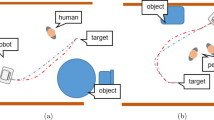Abstract
This project revolves around the combination of different state-of-the-art concepts to create balloon robots which can be used for entertainment purposes. The goal is having multiple robots perform a choreographed flight on preset paths to make use of the “dead space” over the crowd of an event, either as part of the show or displaying information and advertisements. As the balloon is flying on a defined trajectory, a tracking system for its position is needed. For this purpose, several infrared cameras monitor the position of a marker attached to the balloon. The main challenge is overcoming the instabilities of the system to ensure a smooth and precise flight, resulting from the balloons structure: the balloon is filled with helium to counteract the forces of gravity and, therefore, minimize the work needed to keep its momentum. Finding a way to achieve this optimization and the precision mentioned beforehand is the task that we will present and solve in this paper.

















Similar content being viewed by others
References
Kawamura H, Kadota H, Yamamoto M, Takaya T, Ohuchi A (2005) Development of an entertainment indoor blimp robot based on hovering control (in Japanese). J Jpn Soc Fuzzy Theory Intell Inf 17:203–211
Takaya T, Kawamura H, Minagawa Y, Yamamoto M, Ohuchi A (2006) PID landing orbit motion controller for an indoor blimp robot. Artif Life Robot 10:177–184. https://doi.org/10.1007/s10015-006-0385-9
Takaya T, Kawamura H, Minagawa Y, Yamamoto M, Ohuchi A (2008) Learning landing control of an indoor blimp robot for self-energy recharging. Artif Life Robot 12:177–184. https://doi.org/10.1007/s10015-007-0451-y
van der Zwaan S, Bernardino A, Santos-Victor J (2002) Visual station keeping for floating robots in unstructured environments. Robot Auton Syst 39:145–155. https://doi.org/10.1016/S0921-8890(02)00200-2
Kawamura H, Iizuka H, Takaya T, Ohuchi A (2009) Cooperative control of multiple neural networks for an indoor blimp robot. Artif Life Robot 13:504–507. https://doi.org/10.1007/s10015-008-0604-7
OpenCV. http://opencv.org/. Accessed 19 February (2017)
Cunha R, Silvestre C (2005) A 3D path-following velocity-tracking controller for autonomous vehicles. IFAC Proc Vol 38:73–78. https://doi.org/10.3182/20050703-6-CZ-1902.02064
Pedro Aguiar A, Hespanha Joao P (2007) Trajectory-tracking and path-following of underactuated autonomous vehicles with parametric modeling uncertainty. IEEE Trans Autom Control 52:1362–1379. https://doi.org/10.1109/TAC.2007.902731
Tabatabaei SAH, Yousefi-koma A, Ayati M, Mohtasebi SS (2015) Three dimensional fuzzy carrot-chasing path following algorithm for fixed-wing vehicles. 2015 3rd RSI International Conference on Robotics and Mechatronics (ICRoM) 784–788. https://doi.org/10.1109/ICRoM.2015.7367882
Ang Kiam Heong, Chong G, Li Yun (2005) PID control system analysis, design, and technology. IEEE Trans Control Syst Technol 13:559–576. https://doi.org/10.1109/TCST.2005.847331
Acknowledgements
A part of this research was supported by Nihon Stage Co., Ltd. Authors would like to thank Nihon Stage Co., Ltd. for their support.
Author information
Authors and Affiliations
Corresponding author
Additional information
This work was presented in part at the 22nd International Symposium on Artificial Life and Robotics, Beppu, Oita, January 19-21, 2017.
About this article
Cite this article
Nagata, H., Walke, S., Yokoyama, S. et al. Development of entertainment balloon robot system for an indoor event venue. Artif Life Robotics 23, 192–199 (2018). https://doi.org/10.1007/s10015-017-0419-5
Received:
Accepted:
Published:
Issue Date:
DOI: https://doi.org/10.1007/s10015-017-0419-5




